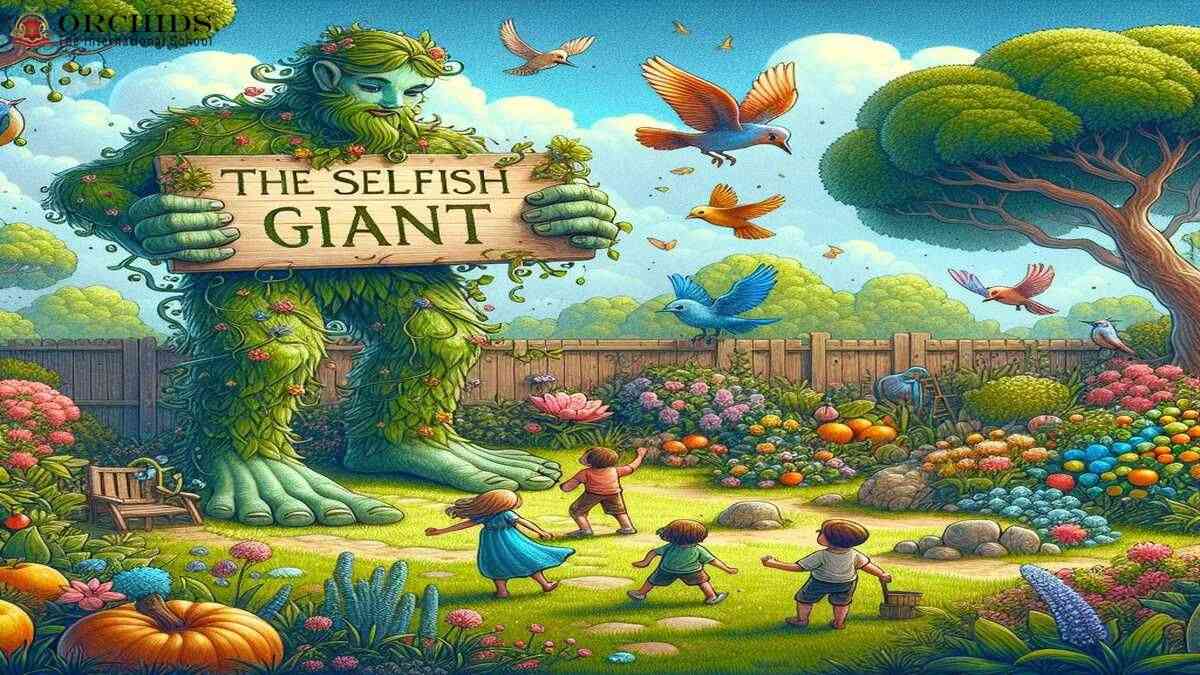The Selfish Giant Story for Kids

The Selfish Giant Story for Kids With Moral
Once upon a time, in a faraway land, there was a beautiful garden adorned with magnificent fruits, melodious birds, striking plants, and verdant shrubs owned by a selfish giant. The giant had a towering wall surrounding his garden, and he forbade children from playing there, selfishly keeping its wonders all to himself.
Little children were unable to enter and play because of the high, towering wall.
Once, the selfish Giant left his exquisite garden to spend a week with a friend. As this was going on, the neighborhood kids discovered a little opening through which they could enter the garden. They had a great time running through the bushes and climbing the branches.
The kids took advantage of the Giant's absence and had a great time in the garden, they all were having fun and playtime. Unfortunately, the Giant arrived back to his garden too early. When he arrived, he saw the children playing and became very irritated with their presence. He then moved everyone out of the garden, sending the unfortunate kids running away like crazy and never returning.
One day, winter refused to leave the land, and spring never arrived. Snowflakes danced relentlessly, covering every inch of the ground. The giant's garden, however, remained untouched by spring's touch. This made the Giant feel bad and depressed.
Until one morning, the Giant noticed something different—a small, fragile flower had dared to bloom amidst the icy cold. But something miraculous began to unfold. One day, the giant heard laughter echoing within the walls. Curiosity drew him closer to the garden's edge, where he found the children sneaking through a hole in the wall, playing joyfully on a tree.
The small tree had burst into blossoms despite the harsh winter, as the children's laughter breathed life into it. Deeply moved by the sight, the Giant's heart softened. He tore down the walls, inviting the children back to play. As a result, spring returned to the garden, flowers bloomed, and birds sang melodies of joy.
One day, the Giant noticed a child crying in the corner. The child had not joined the others in playing. Upon seeing the child's hands and feet, the Giant realized that winter's harshness had taken its toll. With compassion, he lifted the child onto his shoulders. As the Giant's act of kindness melted his heart, something magical happened—the child transformed into something extraordinary
Years passed, and the Giant grew old. But when he needed it most, the child whom he had helped returned, revealing himself as a kind-hearted, loving figure of spring. The Giant, having learned the true meaning of kindness and selflessness, embarked on a new journey, forever surrounded by the beauty of spring in his garden.
Moral of the story: The Selfish Giant
In essence, "The Selfish Giant" teaches that kindness, empathy, and generosity can break down barriers, bring joy, and create a world of beauty and happiness. It underscores the importance of embracing compassion and selflessness to foster meaningful connections and create a harmonious environment for everyone. The story of The Selfish Giant inspires us to be kind, generous, and empathetic, reminding us of the happiness that comes from caring for others and sharing the joys of life.
Frequently Asked Questions
1. Where can I access "The Selfish Giant" story online?
"The Selfish Giant" is available in the public domain, and you can read it on various online platforms and libraries. Access the story for free on websites dedicated to classic literature.
2. Who authored "The Selfish Giant," and what's its literary significance?
Oscar Wilde is the author of "The Selfish Giant," a renowned Irish writer known for his wit and literary contributions. The story holds significance due to its exploration of timeless themes like selfishness and redemption.
3. How does "The Selfish Giant" relate to Aesop's fables?
While not directly related to Aesop's fables, "The Selfish Giant" shares similarities in conveying moral lessons. The story's narrative richness and allegorical elements make it a unique and captivating read.
4. What educational value does "The Selfish Giant" offer?
Teachers can use "The Selfish Giant" to impart lessons on empathy, morality, and literary analysis. The story's accessibility and universal themes make it a valuable resource in educational settings.
5. Can I find "The Selfish Giant" adaptation information for performances or films?
Yes, discover adaptations of "The Selfish Giant" in various artistic forms, including theatrical performances and animated films. The story's enduring appeal has led to diverse creative interpretations.
Other Related Sections
NCERT Solutions | Sample Papers | CBSE SYLLABUS| Calculators | Converters | Stories For Kids | Poems for kids| Learning Concepts I Practice Worksheets I Formulas | Blogs | Parent Resource

